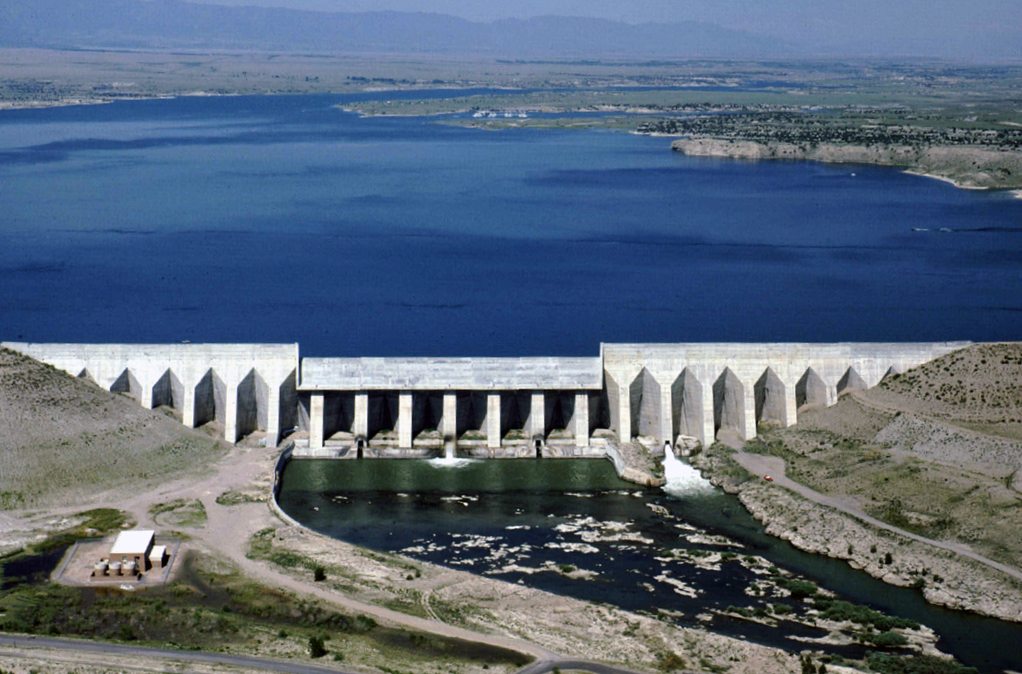Pueblo Reservoir
Current Conditions
Recreation
- Lake Pueblo State Park encompasses the Reservoir, Fish Hatchery and Rock Canyon Swim Beach, located just downstream of Pueblo Dam along the shoreline of the Arkansas River and several fishing access areas. There are two privately owned marinas.
- If you’re spending time on the water:
- Wear a life vest.
- Be aware of conditions! Water in the reservoir can be surprisingly cold—especially in the early summer—and strong winds can develop suddenly, causing watercraft to overturn.
- Don’t drink alcohol while boating.
Dam & Reservoir Basics
Pueblo Dam and Reservoir sit on the Arkansas River, approximately six miles west of Pueblo, Colorado. Constructed between 1970–1975 as part of the Bureau of Reclamation's Fryingpan-Arkansas Project, Pueblo Reservoir provides water storage for agricultural, municipal, and industrial uses, recreation, fish and wildlife.
Pueblo Dam is a massive head buttress dam, giving it a distinct look. The entire dam includes earthworks on either side of the buttresses and spillway and extends for nearly two miles (10,230 feet). The concrete buttresses are 1,750 feet long, up to 245 feet high and 147 feet wide. The buttress dam consists of 530,000 cubic yards of concrete, about 2 billion pounds. Pueblo Reservoir can hold 349,940 acre-feet of water when filled to the spillway crest at elevation 4,919 feet.

The outlet works can move water out of the reservoir in several ways. Water can be released directly to the river but can also move water to other places its need through the Southern Delivery System, the Fountain Valley Conduit, the Pueblo Fish Hatchery and other municipal pipelines. The Arkansas Valley Conduit, beginning construction, will help deliver clean drinking water to cities and towns east of the reservoir.
The bottom of the spillway gates is at 4,796.7 feet. The stream below the dam is approximately 4,756 feet in elevation. The James W. Broderick hydropower plant, completed in 2019 and operated by the Southeastern Colorado Water Conservancy District, sits at the base of the dam.
Flood Control
Pueblo Reservoir is one of the few Reclamation reservoirs in Colorado constructed for flood control. The dam is designed to safely pass floodwaters that would otherwise overtop the dam. That means Pueblo fills to its full capacity only during a flood event.
By keeping approximately 19 vertical feet empty during flood season, the reservoir can help prevent flooding caused by snowmelt and rain from raging down the Arkansas River into Pueblo and to downstream communities.
The Albuquerque, New Mexico District Office of the Army Corps of Engineers manages releases from Pueblo Reservoir when water is stored in the flood pool and requires that from April 15 to November 1, the level in the reservoir does not exceed 256,949 acre-feet.
As part of Pueblo Dam’s role in flood control, the flow at Pueblo Dam may be reduced to help decrease the cumulative flows from the Dam and the tributaries below the Dam to aid in managing the flows at the Avondale gauge below 6,000 cubic feet per second- flows above that could potentially flood downstream towns and agricultural areas.
Arkansas River in Colorado
To track how we and other reservoir operators move water down the Arkansas River and into Pueblo Reservoir throughout the year, please visit the Arkansas Headwaters Association water operations page.
Operations
For detailed information about water operations on the Fryingpan-Arkansas project, watch Storage and Flow Management Benefits, a 13-minute video from Southeastern Colorado Water Conservancy District and for an overview of the project, watch the Fryingpan-Arkansas Project's 50th Anniversary film special, "50 Years of Golden Benefits.”
Voluntary Flow Management Program
The Voluntary Flow Management Program is typically thought of as a rafting program but it also helps fisheries. Between November and April, if possible, based on hydrologic conditions, flows in the Arkansas River are kept lower to support eggs and hatchlings. If you have questions, contact Tom Waters at tom.waters@state.co.us.

